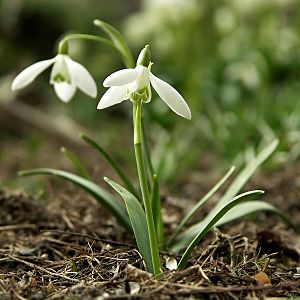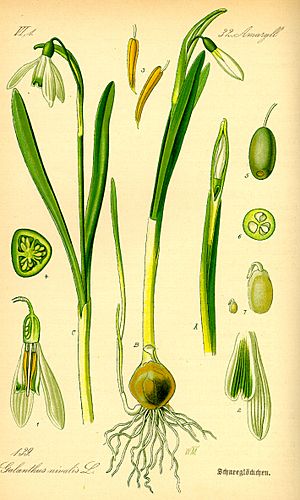Snowdrop facts for kids
Quick facts for kids Snowdrop |
|
|---|---|
 |
|
| Galanthus nivalis common snowdrop |
|
| Scientific classification |
|
| Kingdom: | Plantae |
| Clade: | Tracheophytes |
| Clade: | Angiosperms |
| Clade: | Monocots |
| Order: | Asparagales |
| Family: | Amaryllidaceae |
| Subfamily: | Amaryllidoideae |
| Tribe: | Galantheae |
| Genus: | Galanthus L. |
| Type species | |
| Galanthus nivalis |
|
| Synonyms | |
|
|
The snowdrop is a beautiful little plant known for its early blooms. Its scientific name is Galanthus. This name comes from Greek words meaning "milk flower," which describes its white petals. Snowdrops are a type of herbaceous plant, meaning they have soft stems and do not grow woody like trees.
There are about 20 different kinds, or species, of snowdrops in the world. Each kind has two long, sword-like leaves. They also have a small, white, bell-shaped flower that usually hangs downwards. These lovely flowers are often one of the first signs that winter is ending and spring is on its way.
Contents
What are Snowdrops?
Snowdrops are small flowering plants that belong to the Amaryllidaceae family. This family also includes other well-known flowers like daffodils and amaryllis. Snowdrops are famous for blooming very early in the year. Sometimes, they even push their way through snow and ice! This makes them a symbol of hope and new beginnings.
These plants grow from a bulb, which is like a small underground storage unit. The bulb holds all the food the plant needs to grow and bloom. Each year, new leaves and flowers grow from this bulb.
Where Do Snowdrops Grow?
Snowdrops are native to Europe and parts of Asia. They grow naturally in woodlands, meadows, and rocky areas. You can find them from the Pyrenees mountains in Spain all the way to the Caucasus mountains. They prefer cool, moist places with some shade.
Many people also plant snowdrops in their gardens. They are popular for their beauty and their ability to bloom when most other plants are still dormant. They often grow in large groups, creating a beautiful white carpet on the ground.
When Do Snowdrops Bloom?
Snowdrops are known for being one of the earliest flowers to bloom. They typically appear in late winter or early spring. This can be anywhere from January to March, depending on how cold the winter is. Even if there's still snow on the ground, snowdrops can often be seen peeking through.
Their ability to bloom in cold weather is special. They have a natural "antifreeze" in their cells. This helps them survive freezing temperatures. As the days get longer and the sun gets stronger, the snowdrops begin to grow and open their delicate flowers.
Different Kinds of Snowdrops
While all snowdrops look similar, there are many different species and varieties. The most common one is Galanthus nivalis, often called the common snowdrop. It's the one you'll most likely see in gardens and woodlands.
Other popular types include Galanthus elwesii and Galanthus plicatus. Galanthus elwesii is often larger than the common snowdrop. Galanthus plicatus has leaves that are folded along the edges. Some rare types even have yellow markings instead of green! Plant collectors, called "galanthophiles," love to find and grow these different kinds.
The Life Cycle of a Snowdrop
The life cycle of a snowdrop begins with its bulb. In late summer or autumn, the bulb rests underground. As winter approaches, the bulb starts to prepare for growth. When the temperatures are right and the days start to lengthen, the leaves and flower stalk emerge.
After the flower blooms and is pollinated, it produces seeds. These seeds can then grow into new snowdrop plants. However, snowdrops mostly spread by their bulbs. The main bulb produces smaller "baby" bulbs, called bulbils. These bulbils grow into new plants next to the parent plant. This is why you often see snowdrops growing in clumps.
Once the flowering season is over, usually by late spring, the leaves start to turn yellow and die back. This process is called "dying back" or "senescence." During this time, the plant sends all its energy back down into the bulb. This energy is stored for the next year's growth and bloom. The bulb then rests underground until the next winter, ready to start the cycle all over again.
Images for kids
-
G. nivalis from John Gerard's Herball, 1597
See also
 In Spanish: Galanto para niños
In Spanish: Galanto para niños














